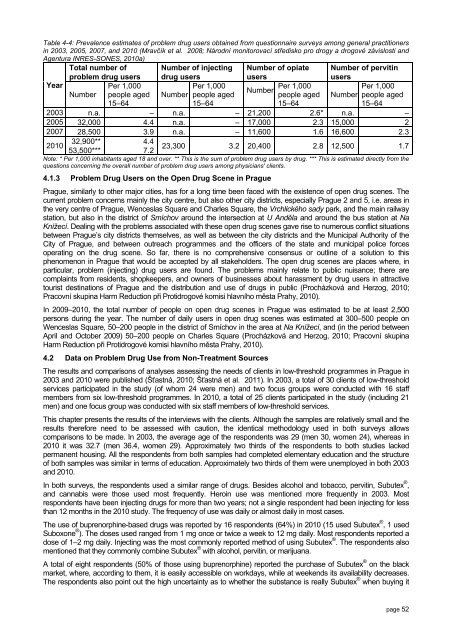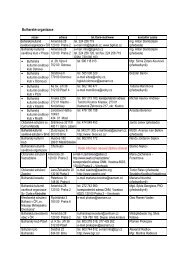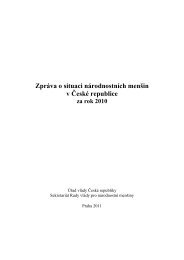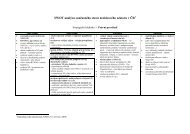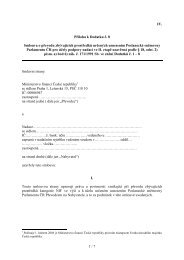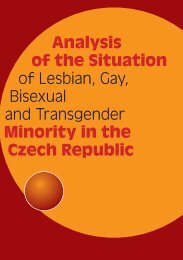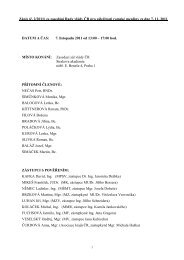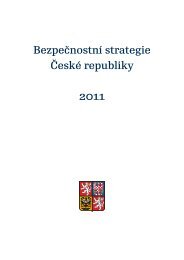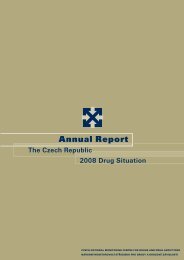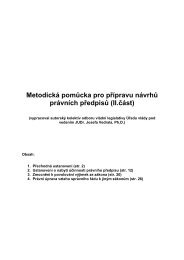The Czech Republic Annual Report 2010 Drug ... - Drogy-info.cz
The Czech Republic Annual Report 2010 Drug ... - Drogy-info.cz
The Czech Republic Annual Report 2010 Drug ... - Drogy-info.cz
You also want an ePaper? Increase the reach of your titles
YUMPU automatically turns print PDFs into web optimized ePapers that Google loves.
Table 4-4: Prevalence estimates of problem drug users obtained from questionnaire surveys among general practitioners<br />
in 2003, 2005, 2007, and <strong>2010</strong> (Mravčík et al. 2008; Národní monitorovací středisko pro drogy a drogové závislosti and<br />
Agentura INRES-SONES, <strong>2010</strong>a)<br />
Total number of Number of injecting Number of opiate Number of pervitin<br />
Year<br />
problem drug users<br />
Number<br />
Per 1,000<br />
people aged<br />
15–64<br />
drug users<br />
Number<br />
Per 1,000<br />
people aged<br />
15–64<br />
users<br />
Number<br />
Per 1,000<br />
people aged<br />
15–64<br />
users<br />
Number<br />
Per 1,000<br />
people aged<br />
15–64<br />
2003 n.a. – n.a. – 21,200 2.6* n.a. –<br />
2005 32,000 4.4 n.a. – 17,000 2.3 15,000 2<br />
2007 28,500 3.9 n.a. – 11,600 1.6 16,600 2.3<br />
<strong>2010</strong><br />
32,900**<br />
53,500***<br />
4.4<br />
7.2<br />
23,300 3.2 20,400 2.8 12,500 1.7<br />
Note: * Per 1,000 inhabitants aged 18 and over. ** This is the sum of problem drug users by drug. *** This is estimated directly from the<br />
questions concerning the overall number of problem drug users among physicians' clients.<br />
4.1.3 Problem <strong>Drug</strong> Users on the Open <strong>Drug</strong> Scene in Prague<br />
Prague, similarly to other major cities, has for a long time been faced with the existence of open drug scenes. <strong>The</strong><br />
current problem concerns mainly the city centre, but also other city districts, especially Prague 2 and 5, i.e. areas in<br />
the very centre of Prague, Wenceslas Square and Charles Square, the Vrchlického sady park, and the main railway<br />
station, but also in the district of Smíchov around the intersection at U Anděla and around the bus station at Na<br />
Knížecí. Dealing with the problems associated with these open drug scenes gave rise to numerous conflict situations<br />
between Prague’s city districts themselves, as well as between the city districts and the Municipal Authority of the<br />
City of Prague, and between outreach programmes and the officers of the state and municipal police forces<br />
operating on the drug scene. So far, there is no comprehensive consensus or outline of a solution to this<br />
phenomenon in Prague that would be accepted by all stakeholders. <strong>The</strong> open drug scenes are places where, in<br />
particular, problem (injecting) drug users are found. <strong>The</strong> problems mainly relate to public nuisance; there are<br />
complaints from residents, shopkeepers, and owners of businesses about harassment by drug users in attractive<br />
tourist destinations of Prague and the distribution and use of drugs in public (Procházková and Herzog, <strong>2010</strong>;<br />
Pracovní skupina Harm Reduction při Protidrogové komisi hlavního města Prahy, <strong>2010</strong>).<br />
In 2009–<strong>2010</strong>, the total number of people on open drug scenes in Prague was estimated to be at least 2,500<br />
persons during the year. <strong>The</strong> number of daily users in open drug scenes was estimated at 300–500 people on<br />
Wenceslas Square, 50–200 people in the district of Smíchov in the area at Na Knížecí, and (in the period between<br />
April and October 2009) 50–200 people on Charles Square (Procházková and Herzog, <strong>2010</strong>; Pracovní skupina<br />
Harm Reduction při Protidrogové komisi hlavního města Prahy, <strong>2010</strong>).<br />
4.2 Data on Problem <strong>Drug</strong> Use from Non-Treatment Sources<br />
<strong>The</strong> results and comparisons of analyses assessing the needs of clients in low-threshold programmes in Prague in<br />
2003 and <strong>2010</strong> were published (Šťastná, <strong>2010</strong>; Šťastná et al. 2011). In 2003, a total of 30 clients of low-threshold<br />
services participated in the study (of whom 24 were men) and two focus groups were conducted with 16 staff<br />
members from six low-threshold programmes. In <strong>2010</strong>, a total of 25 clients participated in the study (including 21<br />
men) and one focus group was conducted with six staff members of low-threshold services.<br />
This chapter presents the results of the interviews with the clients. Although the samples are relatively small and the<br />
results therefore need to be assessed with caution, the identical methodology used in both surveys allows<br />
comparisons to be made. In 2003, the average age of the respondents was 29 (men 30, women 24), whereas in<br />
<strong>2010</strong> it was 32.7 (men 36.4, women 29). Approximately two thirds of the respondents to both studies lacked<br />
permanent housing. All the respondents from both samples had completed elementary education and the structure<br />
of both samples was similar in terms of education. Approximately two thirds of them were unemployed in both 2003<br />
and <strong>2010</strong>.<br />
In both surveys, the respondents used a similar range of drugs. Besides alcohol and tobacco, pervitin, Subutex ® ,<br />
and cannabis were those used most frequently. Heroin use was mentioned more frequently in 2003. Most<br />
respondents have been injecting drugs for more than two years; not a single respondent had been injecting for less<br />
than 12 months in the <strong>2010</strong> study. <strong>The</strong> frequency of use was daily or almost daily in most cases.<br />
<strong>The</strong> use of buprenorphine-based drugs was reported by 16 respondents (64%) in <strong>2010</strong> (15 used Subutex ® , 1 used<br />
Suboxone ® ). <strong>The</strong> doses used ranged from 1 mg once or twice a week to 12 mg daily. Most respondents reported a<br />
dose of 1–2 mg daily. Injecting was the most commonly reported method of using Subutex ® . <strong>The</strong> respondents also<br />
mentioned that they commonly combine Subutex ® with alcohol, pervitin, or marijuana.<br />
A total of eight respondents (50% of those using buprenorphine) reported the purchase of Subutex ® on the black<br />
market, where, according to them, it is easily accessible on workdays, while at weekends its availability decreases.<br />
<strong>The</strong> respondents also point out the high uncertainty as to whether the substance is really Subutex ® when buying it<br />
page 52


